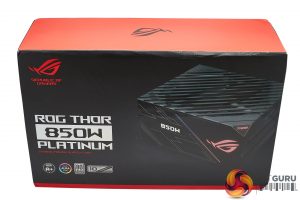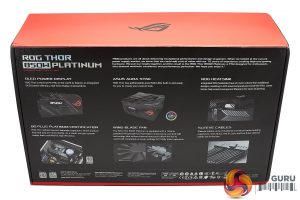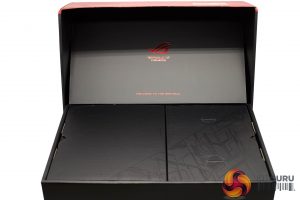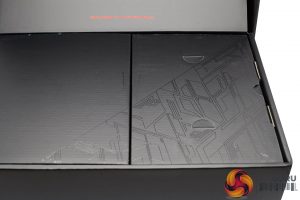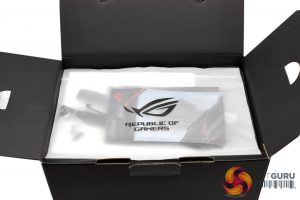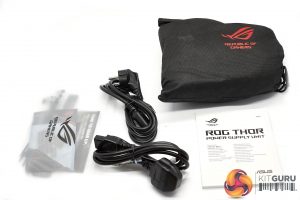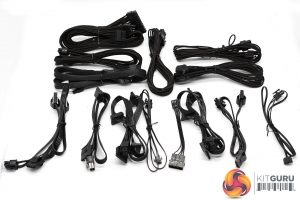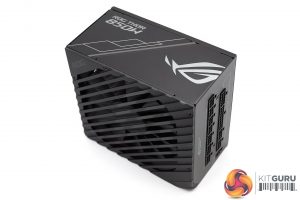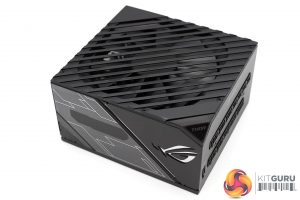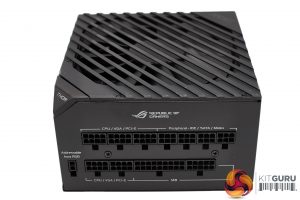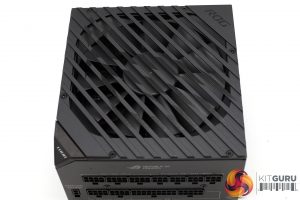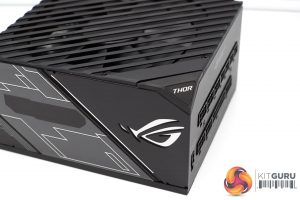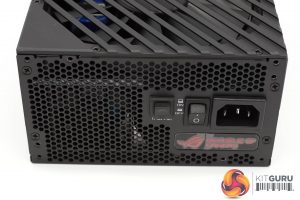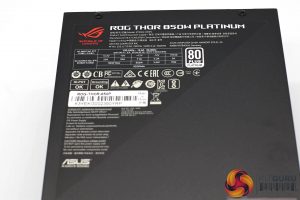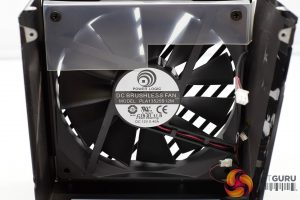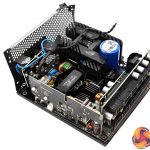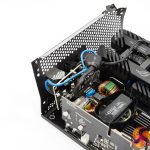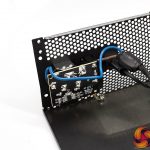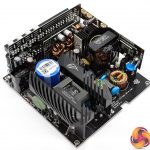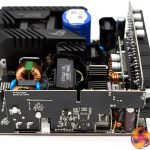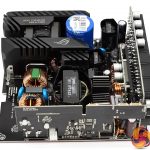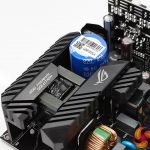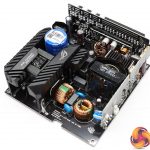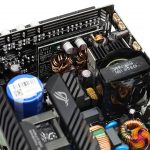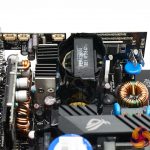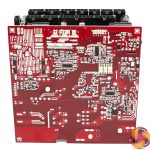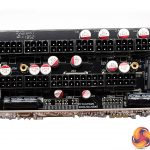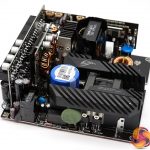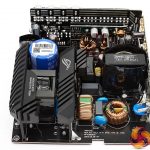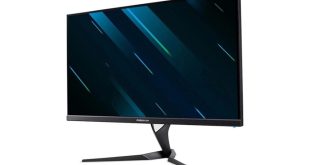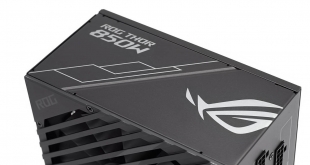
Last year ASUS entered the power supply market. We reviewed their ROG Thor 1200W Power supply, a heavily modified Seasonic unit that delivered superb results – well if you could afford the £315 asking price. Today we take a look at the 850 watt model priced around £200, meaning it will target a much wider audience.
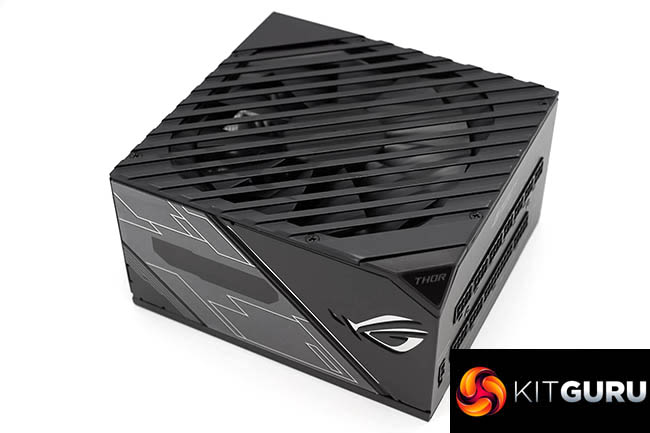
ASUS Republic Of Gamers is a flagship brand for ASUS. Its a well known, high end, and often expensive range of products and the THOR series of power supplies are no exception. ASUS are using 100% Japanese capacitors throughout alongside their patented Wing-Blade fan design with 0db technology.
They are also utilising an integrated heatsink solution which they claim delivers better performance that competing designs with 20% lower load temperatures. This they say will enhance life span.
ASUS seem confident with the design and are offering a 10 year warranty.
Features
– Unique ROG heatsinks and dust-resistant, IP5X-certified Wing-blade fan offer extended component lifespan and 0dB operation
– Certified 80 PLUS Platinum power delivery, with high-end Japanese capacitors and premium components
– World's first consumer PSU featuring integrated OLED Power Display for real-time power consumption monitoring
– Addressable RGB LEDs for advanced customization and lighting control with Aura Sync-compatible ASUS ROG motherboards
Specification
– Intel specification: ATX12V
– Dimensions: 160 x 150 x 86mm
– Efficiency: 80 Plus Platinum
– Protection features: OPP/OVP/SCP/OCP/OTP
– Hazardous materials: ROHS compliance
– AC input range: 100-240V
– RGB lighting: Asus Aura Sync compatible
– DC output voltage: +3.3V, +5V, +12V, -12V, +5Vsb
– Maximum load: 20A, 20A, 71A, 3.6A, 15A
– Total output: 852W
– Warranty: 10yr
I have to say, the presentation of the ASUS ROG THOR 850W power supply is impressive. The box artwork is eyecatching and we like the way some of the key features are showcased on the rear of the box.
When the box is opened, a little panel is pulled to make the top of the box angular. Its a neat visual effect and I don't think I have seen anyone else do this before. Underneath are two boxes which contain the cables and accessories and the power supply itself.
Asus have put a lot of effort into the unboxing experience – even designing the boxes to showcase ROG artwork.
The accessories box – after opening. All the little extras are placed inside a fancy little sleeve.
Inside, there is a little pouch of modular cables, a user manual, two power supply cables and the accessories. Asus include a handful of cable ties, a little ROG badge (very cool addition), mounting screws, felt cable ties and some literature on the unit. They also include some nifty little Cablemod cable combs.
It is interesting to see that ASUS are working a deal with Cablemods for a 20% off voucher. We like all the little touches here.
Connectors
– 1 x 20+4-Pin ATX12V/EPS12V
– 2 x 4+4-Pin ATX12V/EPS12V
– 4 x 6+2-Pin-PCIe
– 12 x SATA
– 5 x 4-Pin-Molex
– 1 x Floppy
The cabling is high quality. The floppy, SATA power cables and Molex are plastic cables. The rest are individually sleeved cables, including the 8 pin, 24 pin and EPS cables.
My initial impression of the 850W model is that it looks very ‘rugged' – like the Dell rugged laptop I used to own. Its all aggressive edges and angular shapes – set to appeal to a gaming oriented audience.
Built to take a beating. The ROG logo is clearly seen on the side. The 850W model is slightly smaller than the 1200W model we reviewed last year. It measures 160x150x86mm (the 1200W model is 190x150x86mm). This means it will fit easier into a wider array of cases. We can see the LED screen on the side – this displays the power you are using when it is running.
The modular bay is well laid out and clearly labelled for ease of installation. At the side is a connector for the addressable AURA RGB. A large fan is hidden behind a mesh of grills along the top of the unit. We will get a closer look at the model of fan when we open the unit up later.
One side is home to the LED screen, the ROG logo and the ‘THOR' writing, which lights up.
The other side of the power supply is home to the power connector, power button and a button to toggle the semi passive operation mode.
| ASUS ROG Thor 850W Power Supply | |||||
|
DC Output
|
+3.3V
|
+5V
|
+12V |
-12V
|
+5Vsb
|
|
Max Output
|
20A
|
20A
|
71A |
0.3A
|
3A
|
| Total Power | 100W MAX | 852W | 3.6W | 15W | |
| 852W | |||||
The single +12V rail is able to deliver 71 Amps which is quite formidable indeed, or 852 watts in total.
Inside the ASUS ROG Thor 850W Power Supply we find a Power Logic 135mm fan (Model: PLA13525B12M). This is a double ball bearing unit.
Below - a High Resolution Gallery of the internal layout of the Power supply.
If you can’t see the image gallery above then you will likely need to white list us in your ad blocker as they are known to interfere with our display code.
The ROG Thor units are based on the Seasonic Prime Ultra Platinum platform and are built to very high standards, as we would expect from Seasonic. The OLED screen is a modification by ASUS which showcases the current power draw. The information delivered to the screen is processed by a micro controller.
The new platform also allows for addressable RGB lighting which can be controlled by a compatible motherboard. Other changes include supersized heatsinks and the aforementioned double ball bearing fan. These new heatsinks mean that ASUS can lower fan speeds, which lowers overall noise. Always welcomed and we delve in this shortly.
All of the heavy power transfers to the parts of the board are delivered through the PCB and not through wires. Only the fans circuit uses some wires.
Most of the filtering for this power supply is handled by polymer capacitors with a few electrolytic caps providing the necessary capacity in the secondary side … to deal with quick transient load changes.
The first part of the transient filter is at the AC receptacle as expected and it includes two Y caps and two X caps. It continues to the main PCB with two Y caps and a single X cap. A MOV is responsible for the protection against surges via the mains grid. The primary Japanese Capacitor is rated 105C – 820uf 400V. Bulk capacitors are Hitachi.
Soldering quality is high, as we would expect from the platform.
Correctly testing power supplies is a complex procedure and KitGuru have configured a test bench which can deliver up to a 2,000 watt DC load. We run at 35c in our environment to greater reflect warmer internal chassis conditions.
We use combinations of the following hardware:
• SunMoon SM-268
• CSI3710A Programmable DC load (+3.3V and +5V outputs)
• CSI3711A Programmable DC load (+12V1, +12V2, +12V3, and +12V4)
• Extech Power Analyzer
• Extech MultiMaster MM570 digital multimeter
• Extech digital sound level meter
• Digital oscilloscope (20M S/s with 12 Bit ADC)
• Variable Autotransformer, 1.4 KVA
We test in a single +12V configuration.
|
DC Output Load Regulation
|
||||||||||
|
Combined DC Load |
+3.3V
|
+5V
|
+12V
|
+5VSB
|
-12V | |||||
|
A
|
V
|
A
|
V
|
A
|
V
|
A
|
V
|
A | V | |
|
85W
|
0.95
|
3.34
|
0.92
|
5.02
|
6.00
|
12.05
|
0.50
|
5.02
|
0.20 | -12.02 |
|
170W
|
1.70
|
3.34
|
1.67
|
5.01
|
12.35
|
12.05
|
1.00
|
5.02
|
0.20 | -12.02 |
|
425W
|
3.00
|
3.34
|
3.05
|
5.01
|
32.20
|
12.04
|
1.50
|
5.01
|
0.30 | -12.02 |
| 640W | 4.05 | 3.33 | 4.05 | 5.01 | 49.00 | 12.04 | 2.00 | 5.01 | 0.30 | -12.03 |
|
850W
|
5.00
|
3.33
|
5.23
|
5.01
|
65.52
|
12.00
|
2.50
|
5.01
|
0.50 | -12.02 |
Load regulation is very strong with the rails holding with 1% of recommended specifications.
| ASUS ROG Thor 850W Platinum Power Supply Review | Maximum Load |
| 965W |
We managed to get the power supply to deliver 965W before it would shut down, delivering around 115W more than rated specifications.
Next we want to try Cross Loading. This basically means loads which are not balanced. If a PC for instance needs 500W on the +12V outputs but something like 30W via the combined 3.3V and +5V outputs then the voltage regulation can fluctuate badly.
| Cross Load Testing | +3.3V | +5V | +12V | -12V | +5VSB | |||||
| A | V | A | V | A | V | A | V | A | V | |
| 760W | 1.0 | 3.34 | 1.0 | 5.01 | 60.0 | 11.98 | 0.2 | -12.01 | 0.50 | 5.02 |
| 165W | 15.0 | 3.32 | 18.0 | 4.97 | 2.0 | 12.03 | 0.2 | -12.02 | 0.50 | 5.01 |
The power supply dealt with the demanding cross load test very well exhibiting little fluctuation. It was tasked with 60A on the +12V rail and it held at 11.98W. The other rails delivered excellent results also.
We then used an oscilloscope to measure AC ripple and noise present on the DC outputs. We set the oscilloscope time base to check for AC ripple at both high and low ends of the spectrum.
ATX12V V2.2 specification for DC output ripple and noise is defined in the ATX 12V power supply design guide.
|
ATX12V Ver 2.2 Noise/Ripple Tolerance
|
|
|
Output
|
Ripple (mV p-p)
|
|
+3.3V
|
50
|
|
+5V
|
50
|
|
+12V1
|
120
|
|
+12V2
|
120
|
|
-12V
|
120
|
|
+5VSB
|
50
|
Obviously when measuring AC noise and ripple on the DC outputs the cleaner (less recorded) means we have a better end result. We measured this AC signal amplitude to see how closely the unit complied with the ATX standard.
| AC Ripple (mV p-p) | ||||
| DC Load | +3.3V | +5V | +12V | 5VSB |
| 100W | 10 | 5 | 15 | 10 |
| 225W | 10 | 5 | 15 | 10 |
| 450W | 10 | 5 | 15 | 10 |
| 675W | 15 | 10 | 20 | 15 |
| 850W | 20 | 10 | 20 | 15 |
Noise suppression is great, peaking at 20mV and 10mV on the +3.3V and +5V rails respectively. The +12V rail peaked at 20mV at full load. Super results all round.
|
Efficiency (%) 240V
|
|
|
100W
|
90.5
|
|
225W
|
92.3
|
|
450W
|
94.1
|
|
675W
|
93.7
|
| 850W | 92.6 |
Efficiency is yet again top of the field, peaking at around 94% at close to 50% load. At full load this drops to around 92.6%.
We take the issue of noise very seriously at KitGuru and this is why we have built a special home brew system as a reference point when we test noise levels of various components. Why do this? Well this means we can eliminate secondary noise pollution in the test room and concentrate on components we are testing. It also brings us slightly closer to industry standards, such as DIN 45635.
Today to test the power supply we have taken it into our acoustics room environment and have set our Digital Sound Level Noise Decibel Meter Style 2 one meter away from the unit. We have no other fans running so we can effectively measure just the noise from the unit itself.
As this can be a little confusing for people, here are various dBa ratings in with real world situations to help describe the various levels.
KitGuru noise guide
10dBA – Normal Breathing/Rustling Leaves
20-25dBA – Whisper
30dBA – High Quality Computer fan
40dBA – A Bubbling Brook, or a Refrigerator
50dBA – Normal Conversation
60dBA – Laughter
70dBA – Vacuum Cleaner or Hairdryer
80dBA – City Traffic or a Garbage Disposal
90dBA – Motorcycle or Lawnmower
100dBA – MP3 Player at maximum output
110dBA – Orchestra
120dBA – Front row rock concert/Jet Engine
130dBA – Threshold of Pain
140dBA – Military Jet takeoff/Gunshot (close range)
160dBA – Instant Perforation of eardrum
|
Noise (dBA)
|
|
|
100W
|
<28.0
|
|
225W
|
<28.0
|
|
450W
|
<28.0
|
|
675W
|
31.2
|
| 850W | 33.8 |
This is a very quite power supply, with such high efficiency and beefy heatsinks, the fan profile is set to be very non aggressive, even at higher loads. It is only when close to full load that you can pick the fan noise up from a few meters away. Its overall an extremely quiet unit.
Full marks to ASUS for their modifications internally. They not only look great, but technically they help improve cooling performance.
|
Temperature (c)
|
||
|
Intake
|
Exhaust
|
|
|
100W
|
37
|
38
|
|
225W
|
38
|
42
|
|
450W
|
39
|
44
|
|
675W
|
43
|
49
|
|
850W
|
45
|
53
|
The fan may not be too active, but the huge heatsinks ensure that the temperatures are maintained throughout the load range. Very impressive results again.
|
Maximum load
|
Efficiency
|
|
965 watts
|
91.7
|
At 965 watts, this unit managed to deliver efficiency at 91.7%. A very strong showing indeed.
There is no doubt in my mind that the ASUS ROG THOR 850W Platinum is one of the finest power supplies on the market in 2019. I don't think you can really get a much better power supply at £200 right now. Not only is it technically very capable, ASUS have taken a solid design and added some useful, practical features to appeal to a demanding audience.
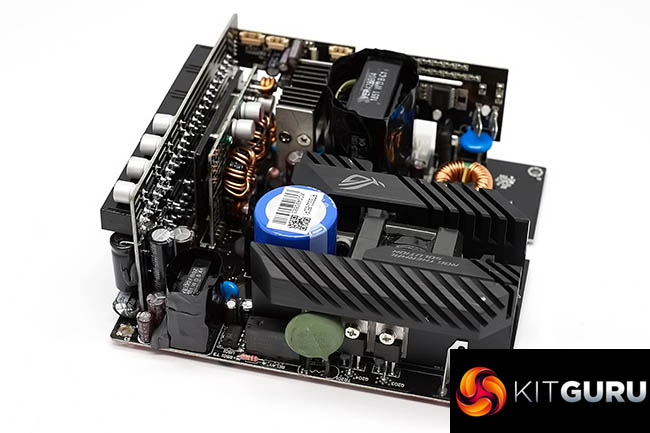
ASUS decision to partner up with Seasonic makes sense to me on a variety of levels. Seasonic are well known to be the market leader, albeit in the upper cost sector of the market. The Republic Of Gamers branding is important to ASUS in the high end, so adopting and tweaking the Prime Ultra Platform was a wise move.
Technically the unit is rock solid. Load regulation, cross load and power delivery are all top notch and the unit was able to deliver over 950 watts before shutting down safely.
Internally the changes and improvements that ASUS made are notable. They have massively enhanced the heatsink cooling configuration to ensure that fan speeds, and subsequently noise can be reduced. The addition of the OLED screen will appeal to case modders and enthusiasts alike. Sure, no one really needs it, but its a cool feature to have and the inclusion of addressable RGB lighting will also be welcomed by many. I couldn't test that feature today, as I prefer to leave the cosmetic side of our reviews to the other team members who produce our video content – but it does look great in operation.
The only downside to owning this unit is the high retail price. At £200 only the strong of heart (and wallet) need apply, but I do feel that if you want one of the highest performing power supplies on the market, along with the extra features such as the OLED screen and addressable RGB then it should certainly be on a final shortlist.
Just be sure not to hide the unit behind a case PSU shroud – that would be criminal!

Our retail partner OCUK are currently selling this unit for £209.99 HERE, which seems to be £10 more than you can find it online at other stores. We are waiting feedback to see if they can reduce their price to match competitors. If you want to get it for £199.99 then check out SCAN and a few other retailers.
Pros:
- Technically very difficult to fault.
- wonderful, comprehensive bundle.
- very quiet under load.
- OLED screen is a nifty additional feature.
- built to look very rugged and futuristic.
- internal improvements help improve noise levels and cooling performance.
Cons:
- It's £200.
KitGuru says: Technically a very proficient power supply set to target the high end audience. The Addressable RGB functionality and OLED screen with power readout will be welcomed by the discerning enthusiast user. It is one of the finest power supples on the market for £200.
 KitGuru KitGuru.net – Tech News | Hardware News | Hardware Reviews | IOS | Mobile | Gaming | Graphics Cards
KitGuru KitGuru.net – Tech News | Hardware News | Hardware Reviews | IOS | Mobile | Gaming | Graphics Cards


